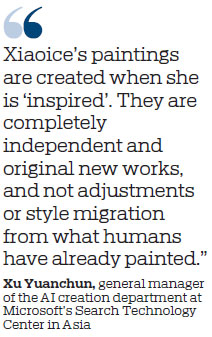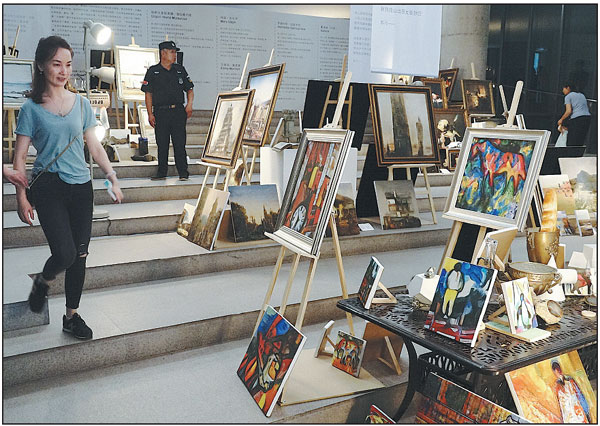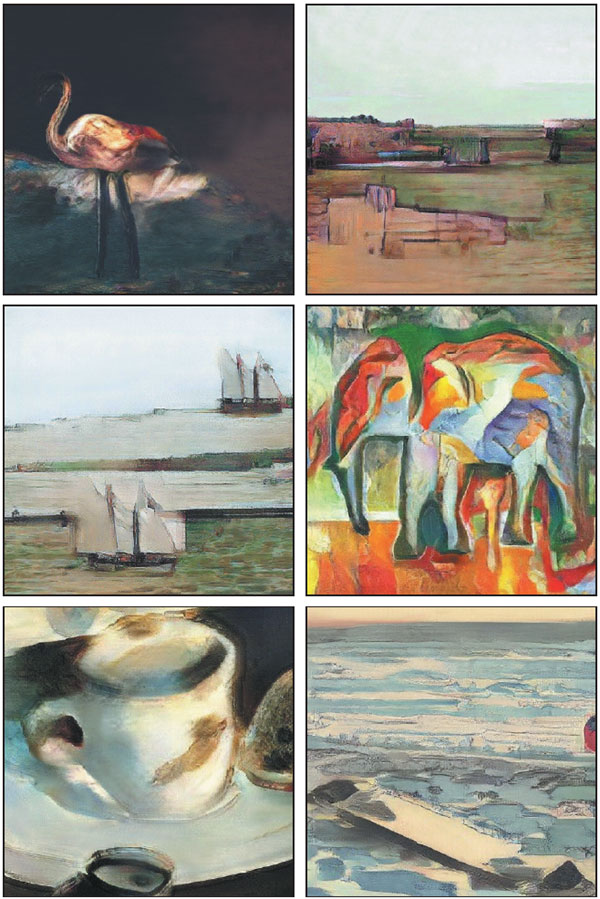Tech is taking the art world by storm
You type it, Xiaoice draws it - artificial intelligence is challenging existing ideas of creativity
In a glitzy hall in Beijing, a special painting exhibition is underway. From the style of Dutch artist Rembrandt van Rijn to Japanese genre Ukiyo-e, the painter presents all the possibilities of what she can achieve. And more importantly, she is an artificial intelligence robot.
Xiaoice, the AI bot developed by tech giant Microsoft, drew more than 100 pictures. And, after learning from 236 painters from the past 400 years in 22 months, Xiaoice can now draw "entirely original" images close to the level of the original artists, and all the paintings are "inspired" by nothing more than text, Microsoft said.
|
Paintings by Xiaoice, an AI robot developed by Microsoft, are displayed at an exhibition in Beijing on July 13. Cheng Gong / For China Daily |
You type it, Xiaoice draws it. Xiaoice's capabilities highlight how rapidly AI is advancing. And the painting exhibition is just part of global tech companies' efforts to prove that AI now can move beyond mechanical, repetitive work to march into the art industry, which demands original thought and has long been viewed as something unique to humans.
"Xiaoice's paintings are created when she is 'inspired'. They are completely independent and original new works, and not adjustments or style migration from what humans have already painted," said Xu Yuanchun, general manager of the AI creation department at Microsoft's Search Technology Center in Asia.
According to him, Xiaoice has millions of different reactions to a source of inspiration just like a person. When users type a word, Xiaoice could draw vastly diverging pictures in response to that word.
"We don't know what surprises Xiaoice will bring us, and the unpredictability is the charm that attracts us," Xu said.
This is not the first time that Xiaoice has created something. Started as a chatting robot in 2014, Xiaoice has already been "talking" with more than 100 million users, published two collections of poetry and released and composed dozens of songs.
All these endeavors have helped accumulate more than 5 million followers on a Chinese micro blog, as Microsoft continues to experiment with how AI can use emotional intelligence to serve as a companion for people and how AI can be used to imbue machines with "creativity".
Elsewhere in the world, researchers and industry participants are also experimenting with AI. In 2017, US singer Taryn Southern unveiled Breaking Free, a song composed and produced by an AI system developed by US startup Amper Music.
Last year, an AI-generated painting of Edmond Belamy became the first of its kind to be auctioned at Christie's. The artwork, created by computer algorithms developed by French AI company Obvious, was sold for more than $430,000.
Just like Xiaoice's paintings, such AI-generated work is based on machine-learning models of artificial neural networks that resemble the human brain and nervous system, which can study input materials and produce output in their own right.
When it comes to AI painting, a neural network that goes by the acronym GAN plays a key role. GAN, which stands for generative adversarial network, creates the image pixel by pixel. Like any other artist or designer, it produces both broad strokes and fine details in layers.

But as pioneering AI-generated works appear around the world, the tech companies and art critics are also addressing the fundamental question of whether the images, poems or songs produced by their networks can be called art at all.
Qiu Zhijie, an artist and professor at China's Central Academy of Fine Arts, said the answer depends on how originality in art is defined when machines are involved in creation.
"When nobody can tell the difference between paintings generated by AI and those of humans, then we can regard AI's work as original," Qiu said.
Apparently, Xiaoice has already passed the test. In May, works produced by the drawing bot under the name Xiao Yubing were submitted to the exhibition of postgraduates' work at China's Central Academy of Fine Arts. When Xiao Yubing's paintings were presented beside those of humans, nobody realized they were generated by AI.
"Art is quite different from industrial products. Audience feedback and personal feelings matter a lot. As long as people feel connected to or inspired by a painting, then we can call it a work of art," said Xu from Microsoft.
He recalled that one of his friends once typed the words: the office is very cold today, as an inspiration for Xiaoice, which then painted a rabbit in snow. The rabbit is white, except for its heart which is faint red. His friend felt touched by the red, which in his eyes signifies warmth in freezing cold.
According to Qiu who has been working closely with Microsoft studying AI creation, Xiaoice has made strides in the past months and now has a stable level of drawing quality.
"The first time I saw her paintings (in January), I only picked three to four from her 20 pictures as impressive. But in May, the number went up to 12 out of 20. Now I could pick as many as eight out of 10 pictures as fantastic," Qiu said.
At the ongoing exhibition, Xiaoice was set into six characters of women artists, representing six painting styles. Fast-learning capabilities allow the drawing bot to quickly master the subtle differences of how to approach the world from six diverging perspectives. Xiaoice could even tell how each painting was affected by each artist's style, Microsoft said.
Based on Xiaoice's impressive drawing capabilities, Microsoft is also exploring how AI could revolutionize the design industry. Xiaoice is now creating fabric designs for international fashion and garment producers, using new AI capabilities to create patterns based on words, themes and colors. These latest works have been produced in partnership with the China Textile Information Center and the China Textiles Development Center.
"It is exciting to know that Xiaoice can develop immaculate designs for the production of fabrics or ready-to-wear collections," said CTDC President Li Binhong.
"In an industry where trends can rapidly evolve on a day-to-day basis, AI will help us to stay ahead of the competition and deliver highly creative collections in record time. It definitely tackles the urgent transformation requirement of the fashion industry," Li added.
Scarves designed by Xiaoice and clothing brand Selected are now available for sale through the latter's 350 outlets in China. More cooperation on design will be unveiled soon, said Xu from Microsoft.
In his eyes, AI's deep involvement in art will also lower the barrier for more people to appreciate fine art, and Xiaoice will become more versatile and be a good companion for people.
"One day, when Xiaoice is given a photo, she will feel inspired and write a song and compose lyrics. After hearing the song, she will feel the need to draw a picture. Seeing the picture, she will be inspired to write a poem. Xiaoice could be on a perpetual creation cycle and better understand humans," Xu said.
masi@chinadaily.com.cn
|
Six paintings by Xiaoice, which are displayed at an exhibition in Beijing on July 13. Photos Provided to China Daily |
(China Daily Global 07/26/2019 page10)




















